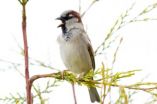(Press-News.org) Some animals produce more offspring than others do. Hormones like prolactin and corticosterone can exercise a crucial influence on the behaviour of birds in the breeding season and therefore on their reproductive success. Scientists from the Max Planck Institute for Ornithology in Radolfzell and their colleagues at the universities of Princeton and Edinburgh have now demonstrated that hormone levels not only play a key role during the breeding season, but already dictate, long in advance, how many eggs a breeding pair will lay, when they will lay them and how often. An animal's hormonal constitution is thus of major significance for its reproductive success, and is possibly an important driving force of evolution. (Proceedings of the Royal Society B, January 19, 2011)
Considerable variance can be observed in the numbers of offspring produced by the members of bird species. Moreover, different individuals within a species embark on the mating and breeding processes at different times. Hormones, the minute messenger molecules that have significant effects on organisms, can assume an important control function in these processes. For example, the concentration of corticosterone increases slightly when an animal is very active, as during brood care. When the bird is exposed to sudden danger and significant stress as a result, its levels rise significantly. In this situation, functions that are not important for survival, for example reproduction, may be suppressed. In contrast, the hormone prolactin stimulates the birds to invest more in reproduction; it controls the number of eggs per clutch and the intensity of brood care.
Together with their colleagues at the University of Edinburgh, Jenny Ouyang from the Princeton University and Michaela Hau from the Max Planck Institute for Ornithology examined how hormone concentrations in individual wild house sparrows (Passer domesticus) before and after the breeding season correlate with reproductive success. These birds often differ significantly in terms of the number of clutches they produce, the number of eggs they lay over the course of a breeding season and how many of their young become fully fledged. Because house sparrows are faithful to their habitats, very specific studies can be carried out on individual birds over an extended period.
The scientists counted the number of eggs, clutches and fledglings for each breeding pair. They also took regular blood samples three weeks before the beginning of breeding and during the rearing of the first clutch, both in natural situations and under artificially generated stress, to determine the corresponding concentrations of the hormones corticosterone and prolactin in the birds' blood. "We were surprised that we could predict how many offspring a breeding pair would have based on hormone levels three weeks before the breeding season," reports Jenny Ouyang. "Sparrows that had low corticosterone values before the breeding season raised the most offspring. Especially birds with low values before, but high values during the season had the highest reproductive success. They apparently invested a lot of energy in the brood." In contrast, the animals that had a very strong hormonal reaction to stress fed their young less and produced fewer offspring.
According to the scientists, prolactin plays a crucial role in the timing of laying the first egg: females with higher prolactin levels started laying earlier and had more offspring as a result. "The fact that the two parents have very similar hormonal values is also fascinating for us," adds Jenny Ouyang. "It is not yet clear whether the couples influence each other's hormonal status or whether they select partners with similar hormone levels."
The results of this study enhance knowledge about the physiological mechanisms that can dictate when a bird breeds, how many eggs it produces per clutch and how often it breeds. The hormones prolactin and corticosterone, in particular, play a more important role in the regulation of individual investments before reproduction begins than was previously assumed. If an individual's hormonal constitution can be inherited, this could provide a fundamental explanation as to why some individuals produce large numbers of offspring and are more successful than others from an evolutionary perspective.
INFORMATION:
Original publication:
Jenny Q. Ouyang, Peter J. Sharp, Alistair Dawson, Michael Quetting, Michaela Hau
"Hormone Levels predict individual differences in reproductive success in a passerine bird"
Proceedings of the Royal Society B. online January 19, DOI: 10.1098/rspb 2010-2490 R1
Hormones dictate breeding success in birds
2011-01-27
ELSE PRESS RELEASES FROM THIS DATE:
The production of plant pollen is regulated by several signaling pathways
2011-01-27
Plants producing flower pollen must not leave anything to chance. The model plant thale cress (Arabidopsis), for instance, uses three signalling pathways in concert with partially overlapping functions. The yield becomes the greatest when all three processes are active; however, two are sufficient to form an acceptable quantity of flower pollen. In a new study, Peter Huijser and his colleagues at the Max Planck Institute for Plant Breeding Research in Cologne offer fascinating insights into the rich range of proteins that are used by seed plants to develop stamens and form ...
Support not punishment is the key to tackling substance abuse and addiction among nurses
2011-01-27
As many as ten to 20 per cent of nurses and nursing students may have substance abuse and addiction problems, but the key to tackling this difficult issue - and protecting public safety - is support and treatment, not punishment. That is the key message in a paper in the February issue of the Journal of Clinical Nursing.
Researchers have recommended six key points that could be built into alternative-to-dismissal (ATD) strategies after reviewing the latest research and professional guidance from countries such as the USA, Canada, New Zealand, Australia and the UK.
They ...
The water temperature in the subtropical Atlantic falls due to wind action
2011-01-27
The temperature of water situated in the subtropical Atlantic experienced a drop of 0.15ºC between 1998 and 2006. This has been revealed by a study led by the IEO (Spanish Oceanography Institute) which suggests that circulation caused by wind could be responsible for this "unusual" behaviour.
Whilst the water temperature in this area, situated along the 24.5º north parallel, from the African coast to the Caribbean, rose by 0.27ºC between 1957 and 1998, researchers have recorded a drop of 0.15ºC in the same area between 1998 and 2006.
"In the ocean there are very ...
'Difficult' patients more likely to experience worse symptoms
2011-01-27
'Difficult' patient-clinician encounters have a negative impact on patients' health outcomes in the short-term, according to a new study by Sheri Hinchey from the Tripler Army Medical Centre in Honolulu and Jeffrey Jackson from the Zablocki VA Medical Centre in Milwaukee. Their findings1 show that nearly 18 percent of patients are perceived as difficult by their physicians and are less likely to trust or be satisfied with their doctor. Importantly, these patients are also more likely to report worse symptoms two weeks after the consultation. Hinchey and Jackson's work has ...
MDC researchers and clinicians identify mediator of blood pressure regulation in the liver
2011-01-27
For 60 years, scientists have puzzled over the possibility of a hepatic osmoreceptor that influences blood pressure regulation. Now, researchers of the Max Delbrück Center for Molecular Medicine (MDC) Berlin-Buch, the Experimental and Clinical Research Center (ECRC) of the MDC and Charité and the Hannover Medical School (MHH) appear to have made a breakthrough discovery. Dr. Stefan Lechner and Professor Gary R. Lewin (both of MDC), Professor Friedrich C. Luft (ECRC) and Professor Jens Jordan (ECRC; now MHH) have discovered a new group of sensory neurons in the mouse liver ...
Infiltrating cancer's recruitment center
2011-01-27
Tel Aviv — The most common connective tissue cell in animals is the fibroblast, which plays an important role in healing wounds. But Dr. Neta Erez of Tel Aviv University's Sackler Faculty of Medicine has now demonstrated that fibroblasts can also do a body great harm, helping to "recruit" immune cells for tumor growth.
At the onset of a tumor's creation when cancer cell proliferation is beginning, fibroblasts rush to the scene to aid in healing. However, Dr. Erez's research shows that these ordinarily helpful cells can actually be turned against the body, enhancing ...
Hardware, software advances help protect operating systems from attack
2011-01-27
The operating system (OS) is the backbone of your computer. If the OS is compromised, attackers can take over your computer – or crash it. Now researchers at North Carolina State University have developed an efficient system that utilizes hardware and software to restore an OS if it is attacked.
At issue are security attacks in which an outside party successfully compromises one computer application (such as a Web browser) and then uses that application to gain access to the OS. For example, the compromised application could submit a "system call" to the OS, effectively ...
Growth-factor-containing nanoparticles accelerate healing of chronic wounds
2011-01-27
Massachusetts General Hospital (MGH) investigators have developed a novel system for delivery of growth factors to chronic wounds such as pressure sores and diabetic foot ulcers. In their work published in the Jan. 18 Proceedings of the National Academy of Sciences, the team from the MGH Center for Engineering in Medicine (CEM) reports fabricating nanospheres containing keratinocyte growth factor (KGF), a protein known to play an important role in wound healing, fused with elastin-like peptides. When suspended in a fibrin gel, these nanoparticles improved the healing of ...
Fishy consequences of transplanting trout, salmon, whitefishes
2011-01-27
This press release is available in French.
Montreal, January 26, 2011 – Not all trout are created equal. Those swimming up the streams of British Columbia might resemble their cousins from Quebec, yet their genetic makeup is regionally affected and has an impact on how they reproduce, grow and react to environmental stressors.
Such regional variance makes transplanting fish species – to bolster dwindling populations – tricky business. These are some of the findings of a compelling review published in Heredity, a journal from the Nature Publishing Group, which examined ...
UNH research recommends new regulatory structure to mitigate financial risk in China
2011-01-27
DURHAM, N.H. – New research from the University of New Hampshire suggests that China should establish a unified supervisory agency, similar to what is used in Singapore, to oversee its complex financial sector.
The new research by Honggeng Zhou, associate professor of decision sciences, and Wenjuan Xie, assistant professor of finance, both at UNH, is presented in the working paper "Challenges for the Unified Financial Supervision in the Post-crisis Era: Singaporean Experience and Chinese Practice." The paper is co-authored by Jing Geng of Harvard University and GuiBin ...





